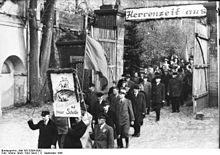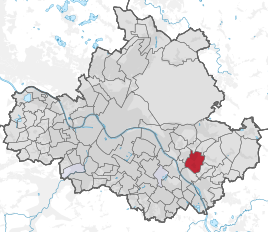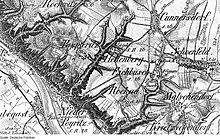Helfenberg (Dresden)
|
Helfenberg
District of the state capital Dresden
Coordinates: 51 ° 2 ′ 14 ″ N , 13 ° 51 ′ 51 ″ E
|
|
|---|---|
| Height : | 260 m above sea level NN |
| Postal code : | 01328 |
| Area code : | 0351 |
|
Location of the district of Helfenberg in Dresden
|
|
Helfenberg is a district in the east of the Saxon capital Dresden . It belongs to the village of Schönfeld-Weißig .
geography
Helfenberg is 9 km east of Dresden city center, the inner old town , and 1 km north of Rockau in the Schönfeld highlands . The Dresden Elbe slopes , which form the steep drop into the Elbe valley , are located directly southwest of Rockau. The Helfenberger location at an altitude of about 260 m above sea level. NN clearly exceeds the valley floor of the Elbe, which is only 2 km away . The district is bordered by the Helfenberger Grund in the west and north in the direction of Pappritz and Gönnsdorf . To the east and south, the agriculturally used plateau forms the transition to the other neighboring districts. These are Cunnersdorf , Eichbusch and Rockau. Helfenberg belongs to the statistical district of Gönnsdorf / Pappritz .
With the neighboring districts Rockau and calibration bush Helfenberg lies in a common district . Although it was formally named after the former manor house of Helfenberg, it is identical in area to the former municipality of Rockau. The actual district of Helfenberg lies in the north of this area. It essentially comprises a large estate with the Helfenberg Castle and a few smaller houses in its vicinity. The building complex of the historic Helfenberg chemical factory , located about 800 m further south-west near Niederpoyritz in the Helfenberger Grund, is also part of the small district, which has retained its village character.
The immediate area is rural; the most important green space in the district is the Helfenberger Park , which also houses the ND78 natural monument . These are two hanging beech trees that have been under protection since 1958 . The district is accessed through the street Am Helfenberger Park . The Helfenberger Weg leads to Cunnersdorf, the Rockauer Ring to Rockau and the Helfenberger Straße to Eichbusch. A path leads through the Helfenberger Grund to Niederpoyritz. The only public transport in Helfenberg is the bus route 98B operated by the transport service provider Müller Busreisen , which runs from Borsberg via Schönfeld to Niederpoyritz.
history
The place name Helfenberg means "To the helping, protection offering mountain" and comes from the Helfenberg Castle , which was located on a mountain spur on the Helfenberger Grund and only a few traces of the ruins are evidence of its ruins. It was first mentioned in 1350 as Castrum Helfenberg in districtu Dresden situm , but dates from the time of the German East Settlement and thus probably existed more than 100 years earlier. In 1397 a document named the location czum Helffenberge ; In 1410 it was referred to as sloss Helffinberg . The name zum Helffenberge has been handed down from 1505.
The lords of the castle had a fore built to the east of the castle to manage the surrounding area , which is mentioned in 1420, 1486 and 1539 as such. It is questionable whether it was founded in an existing peasant hamlet originally settled by Slavs or in an unpopulated place. From this Vorwerk, for which the subordinate farmers had to do labor and whose manor blocks were in the block corridor of Rockau, today's district of Helfenberg developed, which is a parish after Schönfeld .
In the 14th century , the Helfenberg rule belonged to the Burgraves of Dohna . From 1397 it was owned by the von Ziegler gentlemen ; as early as 1400 it passed to the then Meissnian margrave Friedrich IV and became a crown property . The influential citizens of Dresden family received Professional Helfenberg 1445, from 1510, the practiced noble family Karras , the basic rule out. In 1535, the lords of Carlowitz became the new owners before Elector Moritz transferred the estate to Hans von Dehn-Rothfelser in the early 1550s . His heirs held interest rights in Helfenberg until 1760.
Around the middle of the 16th century , the landlord moved from the castle to the newly built mansion , the Helfenberg Castle, on the Vorwerk site . The castle was still habitable for the time being and defied the attacks of the Thirty Years War , but fell into disrepair from the 17th century and was largely demolished in the 18th century .
The manor that emerged from the Vorwerk in 1627 included a barn, stables, gardens, a brickyard , a brewery , a water-powered mill and several ponds , mainly used for fish farming , in addition to the manor house . The neighboring district of Eichbusch later developed from the estate's own sheep farm , which in turn became a Vorwerk Helfenberg ; A total of 13 villages were then under the rule of Helfenberg.
A park was probably created south of the manor house at the beginning of the 17th century . When Helfenberg was owned by Earl Findlater in the early 19th century , it was redesigned in the English style . In 1811, the estate was passed on to his partner and private secretary Johann Georg Christian Fischer, who lived in Helfenberg until his death in 1860.
In 1872, the chemist Eugen Dieterich took over the estate's own mill in Helfenberger Grund, which had meanwhile become a paper mill . Here he manufactured adhesive plasters and other medical and pharmaceutical products and founded the chemical factory in Helfenberg . At the latest when it was converted into a stock corporation in 1898, this chemical factory became a major international exporting company that was only expropriated in the GDR era. Today there is mainly commercial space here.

The Albertiner , the Saxon royal family, took over the Helfenberger and the neighboring Gönnsdorf manor in 1878. The management was carried out by changing tenants. After the abolition of the monarchy , the house association Albertine Line e. V. the estate, whereby the Wettins were still the landlords. After the Second World War they were expropriated as part of the land reform . The lands were distributed to new farmers ; Helfenberg had already become part of the Rockau rural community . A large part of the estate was used for agriculture until 1990 . Today the houses are mostly empty.
In the past century, very few new buildings were added to the site. On January 1, 1994, Rockau, and thus also Helfenberg, merged with other communities in the surrounding area to form Schönfeld-Weißig . Exactly five years later this was incorporated into Dresden and Rockau with Eichbusch and Helfenberg has since been part of the state capital.
Population development
|
people
- Eugen Dieterich (* 1840 in Waltershausen (Lower Franconia), † 1904 in Helfenberg), German chemist and pioneer in the pharmaceutical industry in Germany
- Max Uhlig (* 1937 in Dresden), German painter, lives in Helfenberg on the site of the former chemical factory
See also
Individual evidence
- ↑ Dresden.de: District 46 - Gönnsdorf / Pappritz with Cunnersdorf, Eichbusch, Helfenberg and Rockau (PDF; 347 kB)
- ↑ Hanging bookings at Helfenberger Park. Archived from the original on January 25, 2013 ; accessed on April 24, 2013 (photo of the natural monument signage by Matthias Erfurth).
- ↑ Protected areas according to the Nature Conservation Act. (PDF; 155 kB) In: Environmental Atlas 04/2008. Environmental Office of the City of Dresden, accessed on April 24, 2013 .
- ^ Scheduled services from Müller Busreisen
- ↑ a b Helfenberg in the Digital Historical Directory of Saxony



